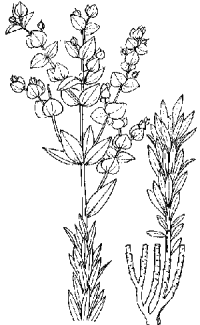 Synonyms: Tithymalus
paralias (L.) J. Hill, 1768
Synonyms: Tithymalus
paralias (L.) J. Hill, 1768Euphorbia paralias Linnaeus, 1753
 Synonyms: Tithymalus
paralias (L.) J. Hill, 1768
Synonyms: Tithymalus
paralias (L.) J. Hill, 1768
Common names: Engl: Sea spurge; Bulg: Primorska mlechka; Russ: Molochay pribrezhny; Turk: Sutlegen; Ukr: Molochay pryberezhny
Order: EUPHORBIALES
Family: EUPHORBIACEAE
Taxonomic descriptions: It is a dwarf semishrub up to 60 cm, tall, glabrous, with numerous thick upright densely leaved stems; leaves are setiform, 10-30 mm long, 1-6 mm in width; inflorescence of 3-5 branches; bracts are ovate, cyathium is small, wide; seeds are wrinkled.
 IUCN Status:
IUCN Status:
World level: NE
Black Sea Regional level: EN
Subregion level: EN
Distribution:
Habitats type, Critical habitats, Limiting factors: Coastal sands. Critical habitats: coasts of the Crimea (Sevastopol, Laspi, Alushta, Karadag) and Caucasus (southernwards from Novorossiysk). Limiting factors: unknown; probably, the low level of its competition ability in coastal plant communities.
Biology: Bloom - from June to September, fruitage - from July to October. Successful seed propagation. Deep tap root system, psammophyte, mesoxerophyte, halophyte.
Population trends: Declining in abundance.
Threats: Lack of non-modified sites along the coast that is due to the development of the coast into resort zone.
Conservation measures taken: The species is protected in the Karadag natural reserve (the Crimea, Ukraine), listed in the Red Data Book of Bulgaria.
Conservation measures proposed: Establishment of new reserves in Bulgaria, Turkey, Georgia.
References:
Compiled by: A.Yena